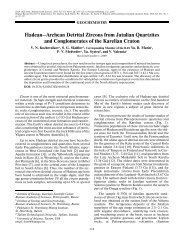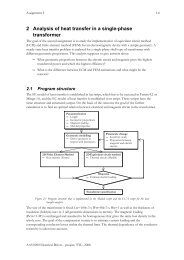power electronics and electrical drives - of / [www.ene.ttu.ee]
power electronics and electrical drives - of / [www.ene.ttu.ee]
power electronics and electrical drives - of / [www.ene.ttu.ee]
You also want an ePaper? Increase the reach of your titles
YUMPU automatically turns print PDFs into web optimized ePapers that Google loves.
1.4. Developments in the field <strong>of</strong> <strong>electrical</strong> <strong>drives</strong>In the analysis <strong>of</strong> developments in electric <strong>drives</strong>, we can study trends related to electricmachines, <strong>power</strong> converters <strong>and</strong> control devices as well as to the control principles separately.The technology <strong>of</strong> <strong>electrical</strong> machines is quite conservative, so no substantial changes duringthe next years are expected. In industrial applications the most important type <strong>of</strong> electricmotors is still the AC induction motor. Reductions in the production <strong>of</strong> conventional DCmotors are typical. DC motors with electronic collectors will be widely used instead thetraditional DC motors. The permanent magnet alternating current machines (PMAC) are mor<strong>ee</strong>xtensive than motors with excitation windings, however PMAC machines have very goodtechnical <strong>and</strong> economic parameters. Synchronous motors with excitation winding suit the bestfor high <strong>power</strong> applications, when use <strong>of</strong> permanent magnets is excessively expensive. Theswitched reluctance motors can also be used to drive small <strong>power</strong> mechanisms. In traditionaltextbooks reluctance machines are described as low efficiency machines (approx. 50 %), buttheir modern application in vector controlled <strong>drives</strong> is more effective <strong>and</strong> their efficiency is inthe same order as that <strong>of</strong> induction motors. Because most <strong>of</strong> the electric motors are fed from<strong>power</strong> converters <strong>and</strong> have a complex control system <strong>and</strong> approximately the same outputcharacteristics, it is difficult to classify <strong>drives</strong> <strong>and</strong> motors according traditional principles.Vector controlled AC motors can be used as DC motors to get the same technical properties.In many cases, dimensions <strong>of</strong> <strong>power</strong> converters are so small that they could be mounted on amotor’s frame. The integration <strong>of</strong> a motor <strong>and</strong> a converter allows a common cooling system tobe used <strong>and</strong> the wiring betw<strong>ee</strong>n the motor <strong>and</strong> the converter to be minimized.The efficiency <strong>and</strong> reliability <strong>of</strong> <strong>electrical</strong> machines <strong>and</strong> <strong>drives</strong> will increase resulting fromadvanced design s<strong>of</strong>tware packages, computer-aided design (CAD) methods <strong>and</strong> high qualitymaterials. The weight <strong>of</strong> machines per unit <strong>power</strong> will decrease. The most common methodfor the design <strong>of</strong> different machines <strong>and</strong> devices is the finite element method (FEM). It is usedto calculate electric <strong>and</strong> magnetic fields as well as thermal fields or mechanical stresses. Inview <strong>of</strong> future <strong>ene</strong>rgy costs rising, a higher efficiency <strong>and</strong> reliability must be preferred to alower initial cost <strong>of</strong> a machine.In most <strong>of</strong> industrial applications, the AC induction motor <strong>drives</strong> with frequency convertersare used. The simple principle scalar control (the voltage <strong>and</strong> frequency are variedproportionally) is used to control the sp<strong>ee</strong>d <strong>of</strong> pumps, fans <strong>and</strong> compressors. The mostcomplicated principle <strong>of</strong> vector control is used to control the <strong>drives</strong> <strong>of</strong> machine tools, robots,transport machines etc. In servo <strong>drives</strong>, the permanent magnet synchronous motor (PMSM) isthe optimal solution.Many methods <strong>of</strong> modern information technology will be also used in <strong>drives</strong>. Remote controlvia information networks (incl. Internet), on-line parameter identification, machinediagnostics, <strong>and</strong> human-machine interface functions will be added to the modern <strong>drives</strong>.Artificial intelligence <strong>and</strong> neural networks will be part <strong>of</strong> modern drive control systems.12


![power electronics and electrical drives - of / [www.ene.ttu.ee]](https://img.yumpu.com/45392281/12/500x640/power-electronics-and-electrical-drives-of-wwwenettuee.jpg)


![Nutman et al.2010.pdf - of / [www.ene.ttu.ee]](https://img.yumpu.com/49144272/1/190x253/nutman-et-al2010pdf-of-wwwenettuee.jpg?quality=85)
![Kogu kursuse konspekt - of / [www.ene.ttu.ee]](https://img.yumpu.com/48975288/1/184x260/kogu-kursuse-konspekt-of-wwwenettuee.jpg?quality=85)
![TEHNILINE JOONESTAMINE - of / [www.ene.ttu.ee]](https://img.yumpu.com/48482018/1/184x260/tehniline-joonestamine-of-wwwenettuee.jpg?quality=85)

![Mäeinstituudi uudiskiri nr - of / [www.ene.ttu.ee] - Tallinna ...](https://img.yumpu.com/45808782/1/190x245/maeinstituudi-uudiskiri-nr-of-wwwenettuee-tallinna-.jpg?quality=85)
![2. Loogikafunktsioonid ja loogikalülitused - of / [www.ene.ttu.ee]](https://img.yumpu.com/44975782/1/184x260/2-loogikafunktsioonid-ja-loogikala-1-4-litused-of-wwwenettuee.jpg?quality=85)
![NAFTA â MUST KULD - of / [www.ene.ttu.ee] - Tallinna Tehnikaülikool](https://img.yumpu.com/43448902/1/190x245/nafta-a-must-kuld-of-wwwenettuee-tallinna-tehnikaa-1-4-likool.jpg?quality=85)
![I OSA TUGEVUSÃPETUS - of / [www.ene.ttu.ee]](https://img.yumpu.com/43043675/1/184x260/i-osa-tugevusapetus-of-wwwenettuee.jpg?quality=85)
![TEHNILINE KOMMUNIKATSIOON - of / [www.ene.ttu.ee]](https://img.yumpu.com/42741483/1/184x260/tehniline-kommunikatsioon-of-wwwenettuee.jpg?quality=85)
![TEHNILINE KOMMUNIKATSIOON - of / [www.ene.ttu.ee]](https://img.yumpu.com/42288976/1/184x260/tehniline-kommunikatsioon-of-wwwenettuee.jpg?quality=85)
![JÃUELEKTROONIKA - of / [www.ene.ttu.ee]](https://img.yumpu.com/41203306/1/184x260/jauelektroonika-of-wwwenettuee.jpg?quality=85)
![Välitöö aruanne 3 - of / [www.ene.ttu.ee] - Tallinna Tehnikaülikool](https://img.yumpu.com/40993804/1/190x245/valitaa-aruanne-3-of-wwwenettuee-tallinna-tehnikaa-1-4-likool.jpg?quality=85)